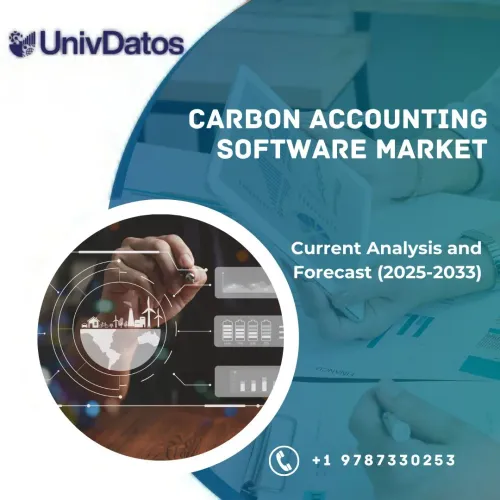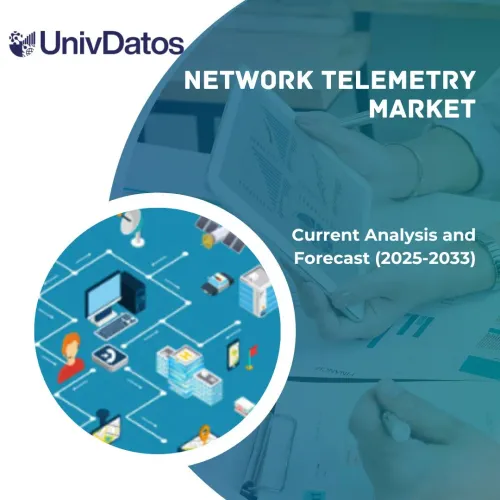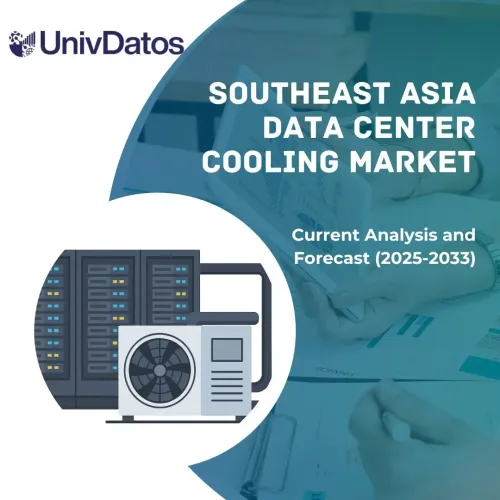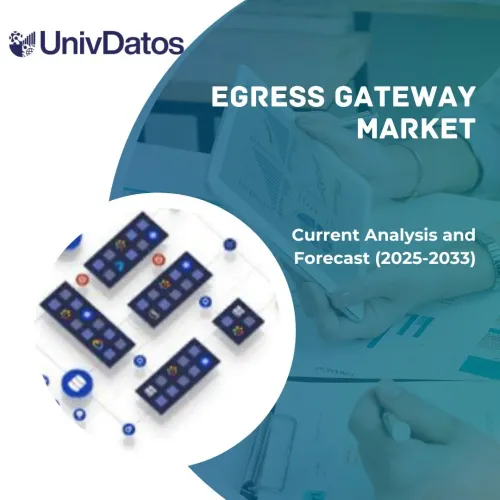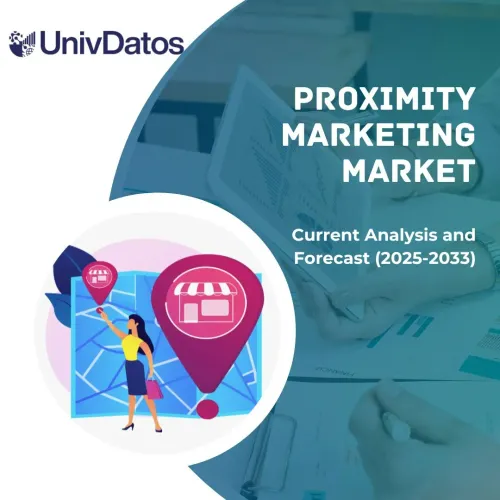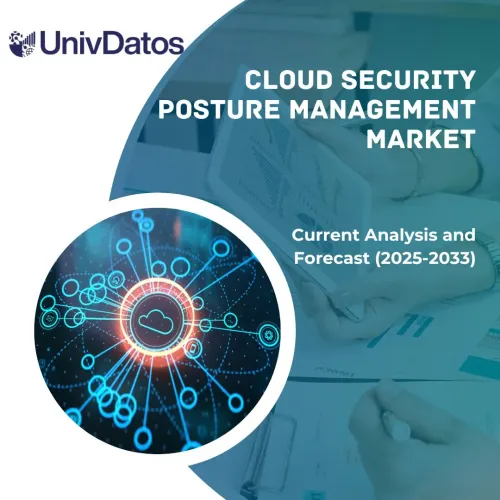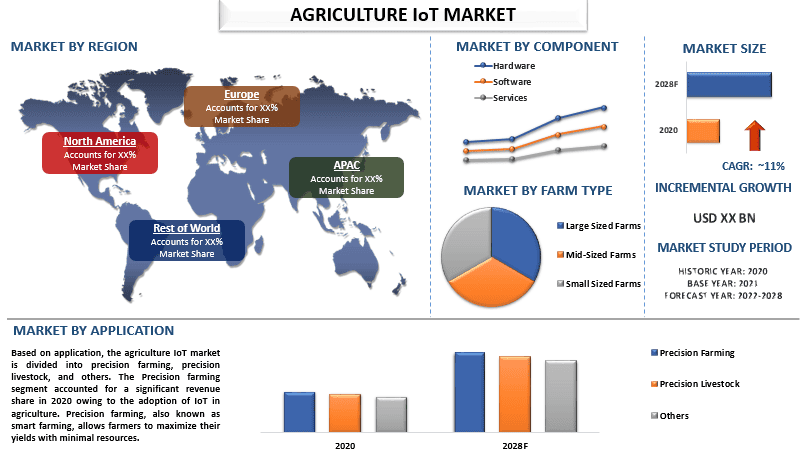
전 세계 농업 IoT 시장은 예측 기간 동안 약 11%의 상당한 성장률을 보일 것으로 예상됩니다. 농업 산업의 IoT는 농부들이 작물의 품질과 토지의 비옥도를 유지하는 데 도움이 되어 제품의 양과 품질을 향상시킵니다. 따라서 IoT 장치의 도움으로 센서에서 데이터를 캡처하여 작물의 실시간 상태를 알 수 있습니다. 또한 인터넷 보급률 및 스마트폰 사용자 증가로 인해 농업 부문의 최신 기술에 대한 농부들의 인식이 높아지면서 농업 IoT 시장을 견인할 것으로 예상됩니다. 더욱이 농업 부문은 주요 국가의 GDP에 상당한 기여를 합니다. 예를 들어, 농업, 식품 및 관련 산업은 2020년 미국 국내 총생산(GDP)에 1조 550억 달러(미국 전체 경제의 5% 점유율)를 기여했습니다. 더욱이 농산물에 대한 수요 증가, 기술 발전, 농부들의 IoT 장치 채택 증가 등이 있습니다. 따라서 다양한 민간 기업과 정부가 식량 수요 증가에 따라 정밀 농업의 기술 개발을 주도하고 있습니다. 유엔 식량 농업 기구에 따르면 2021년에 7억 2백만 명에서 8억 2천 8백만 명 사이의 사람들이 기아에 시달렸습니다.
Deere & Company, Trimble Inc, Raven Industries, AKVA Group ASA, Topcon Positioning Systems Inc., AgJunction Inc., Ponsse Oyj, Komatsu Forest AB, InnovaSea Systems Inc., AGCO Corporation.는 시장의 주요 업체 중 일부입니다. 하이테크 및 혁신적인 제품/기술로 고객을 지원하기 위해 이러한 업체들은 여러 M&A와 파트너십을 체결했습니다.
보고서에 제시된 통찰력
“구성 요소 중 하드웨어 부문이 2020년에 시장에서 상당한 점유율을 차지할 것입니다.”
구성 요소를 기준으로 시장은 하드웨어, 소프트웨어 및 서비스로 분류됩니다. 이 중 하드웨어 부문은 2020년에 전 세계 농업 IoT 시장에서 두드러진 점유율을 차지했으며 예측 기간 동안 견조한 성장을 보일 것으로 예상됩니다. 이는 농업에서 드론, GPS, 관개 제어기, 안내 및 유도 시스템, 수확량 모니터 및 센서와 같은 스마트 장치의 채택이 높기 때문입니다.
“농장 유형 중 소규모 농장 범주가 예측 기간 동안 상당한 CAGR을 보일 것입니다.”
농장 유형을 기준으로 시장은 대규모 농장, 중규모 농장, 소규모 농장으로 분류됩니다. 이 중 소규모 농장이 2020년에 시장에서 상당한 점유율을 차지할 것입니다. 이는 주로 농장 자동화 장비의 비용 감소와 투자 수익률을 높이기 위해 소규모 농장에서도 자동화 도구를 더 실용적으로 배치할 수 있도록 하는 기술 발전 때문입니다.
“응용 분야 중 정밀 농업 부문이 2020년에 시장에서 상당한 점유율을 차지할 것입니다.”
응용 분야를 기준으로 농업 IoT 시장은 정밀 농업, 정밀 축산 및 기타로 분류되었습니다. 정밀 농업 범주는 예측 기간 동안 더 높은 채택률을 보일 것입니다. 이는 연결된 장치의 실시간 작동 조건을 감지하여 물과 영양소 수준을 감지하고 토양 조건 및 기타 관련 매개변수를 분석하여 운영 효율성을 높일 수 있습니다.
“아시아 태평양이 시장에서 상당한 점유율을 차지할 것입니다.”
2020년에는 아시아 태평양이 예측 기간 동안 상당한 CAGR로 성장할 것으로 예상됩니다. 농업 산업에 생산성 향상에 대한 압력을 가하여 농업 IoT와 같은 첨단 기술의 채택을 증가시키는 급증하는 인구와 같은 주요 요인. UNFPA 아시아 태평양에 따르면 아시아 태평양 지역은 세계 인구의 60%인 약 43억 명이 거주하고 있으며 세계에서 가장 인구가 많은 국가인 중국과 인도를 포함합니다. 또한 이 지역의 주요 산업 플레이어의 존재와 제품 출시 건수 증가는 시장 성장에 기여하는 요인이기도 합니다. 아시아 태평양 지역 정부의 이러한 긍정적인 이니셔티브와 경제 성장은 농부들 사이에서 농업 분야의 IoT 통합을 주도하고 있습니다. 따라서 시장 성장을 촉진합니다.
이 보고서를 구매해야 하는 이유:
- 이 연구에는 인증된 주요 산업 전문가가 검증한 시장 규모 측정 및 예측 분석이 포함되어 있습니다.
- 이 보고서는 전체 산업 성과에 대한 빠른 검토를 한눈에 제공합니다.
- 이 보고서는 주요 비즈니스 재무, 제품 포트폴리오, 확장 전략 및 최근 개발에 대한 주요 초점을 두고 주요 산업 동료에 대한 심층 분석을 다룹니다.
- 산업 전반에 걸쳐 존재하는 동인, 제약, 주요 추세 및 기회에 대한 자세한 조사.
- 이 연구는 다양한 부문에 걸쳐 시장을 포괄적으로 다룹니다.
- 산업에 대한 심층적인 지역 수준 분석.
맞춤화 옵션:
전 세계 농업 IoT 시장은 요구 사항 또는 기타 시장 부문에 따라 더욱 맞춤화할 수 있습니다. 이 외에도 UMI는 귀하가 자체 비즈니스 요구 사항을 가질 수 있음을 이해하므로 귀하의 요구 사항에 완전히 맞는 보고서를 얻으려면 언제든지 저희에게 연락하십시오.
목차
농업 IoT 시장 분석 (2022-2028)을 위한 연구 방법론
글로벌 농업 IoT 시장의 과거 시장 분석, 현재 시장 추정, 미래 시장 예측은 주요 지역에서 농업 IoT 도입을 분석하고 평가하기 위해 수행된 3가지 주요 단계였습니다. 과거 시장 데이터를 수집하고 현재 시장 규모를 추정하기 위해 철저한 2차 연구가 수행되었습니다. 둘째, 이러한 통찰력을 검증하기 위해 수많은 결과와 가정이 고려되었습니다. 또한 글로벌 농업 IoT 시장의 가치 사슬 전반에 걸쳐 업계 전문가와 광범위한 1차 인터뷰가 진행되었습니다. 1차 인터뷰를 통해 시장 수치를 가정하고 검증한 후, 전체 시장 규모를 예측하기 위해 하향식/상향식 접근 방식을 사용했습니다. 이후 시장 세분화 및 데이터 삼각 측량 방법을 채택하여 관련 산업의 세그먼트 및 하위 세그먼트의 시장 규모를 추정하고 분석했습니다. 자세한 방법론은 아래에 설명되어 있습니다.
과거 시장 규모 분석
1단계: 2차 출처 심층 연구:
연례 보고서 및 재무 제표, 실적 발표, 보도 자료 등과 같은 회사 내부 출처와 저널, 뉴스 및 기사, 정부 간행물, 경쟁사 간행물, 섹터 보고서, 타사 데이터베이스 및 기타 신뢰할 수 있는 간행물을 포함한 외부 출처를 통해 농업 IoT 시장의 과거 시장 규모를 파악하기 위해 상세한 2차 연구가 수행되었습니다.
2단계: 시장 세분화:
농업 IoT 시장의 과거 시장 규모를 파악한 후, 주요 지역의 다양한 세그먼트 및 하위 세그먼트에 대한 과거 시장 통찰력과 점유율을 수집하기 위해 자세한 2차 분석을 수행했습니다. 주요 세그먼트는 보고서에 구성 요소, 농장 유형 및 애플리케이션으로 포함됩니다. 해당 지역에서 테스트 모델의 전체적인 도입을 평가하기 위해 추가 국가 수준 분석이 수행되었습니다.
3단계: 요인 분석:
다양한 세그먼트 및 하위 세그먼트의 과거 시장 규모를 확보한 후, 농업 IoT 시장의 현재 시장 규모를 추정하기 위해 자세한 요인 분석을 수행했습니다. 또한 농업 IoT의 IoT 기반 스마트 농업 도입 증가와 같은 종속 변수와 독립 변수를 사용하여 요인 분석을 수행했습니다. 전 세계 농업 IoT 시장 부문에서 최고의 파트너십, 인수 합병, 사업 확장 및 제품 출시를 고려하여 수요 및 공급 측면 시나리오에 대한 철저한 분석이 수행되었습니다.
현재 시장 규모 추정 및 예측
현재 시장 규모 측정: 위의 3단계에서 얻은 실행 가능한 통찰력을 바탕으로 현재 시장 규모, 글로벌 농업 IoT 시장의 주요 기업, 세그먼트의 시장 점유율을 파악했습니다. 필요한 모든 비율 점유율 분할 및 시장 분석은 위에서 언급한 2차 접근 방식을 사용하여 결정되었으며 1차 인터뷰를 통해 확인되었습니다.
추정 및 예측: 시장 추정 및 예측을 위해 동인 및 추세, 제약, 이해 관계자가 이용할 수 있는 기회를 포함한 다양한 요인에 가중치가 할당되었습니다. 이러한 요인을 분석한 후 관련 예측 기술, 즉 하향식/상향식 접근 방식을 적용하여 전 세계 주요 시장에서 다양한 세그먼트 및 하위 세그먼트에 대한 2028년 시장 예측을 도출했습니다. 시장 규모를 추정하기 위해 채택된 연구 방법론은 다음을 포함합니다.
- 수익(USD) 측면에서 업계의 시장 규모와 주요 시장에서 농업 IoT 시장의 도입률
- 시장 세그먼트 및 하위 세그먼트의 모든 비율 점유율, 분할 및 분석
- 제공되는 제품 측면에서 글로벌 농업 IoT 시장의 주요 기업. 또한 빠르게 성장하는 시장에서 경쟁하기 위해 이러한 기업이 채택한 성장 전략
시장 규모 및 점유율 검증
1차 연구: 주요 지역의 최고 경영진(CXO/VP, 영업 책임자, 마케팅 책임자, 운영 책임자, 지역 책임자, 국가 책임자 등)을 포함한 주요 오피니언 리더(KOL)와 심층 인터뷰를 실시했습니다. 그런 다음 1차 연구 결과를 요약하고 명시된 가설을 증명하기 위해 통계 분석을 수행했습니다. 1차 연구의 입력은 2차 결과와 통합되어 정보를 실행 가능한 통찰력으로 전환했습니다.
여러 지역의 1차 참가자 분할
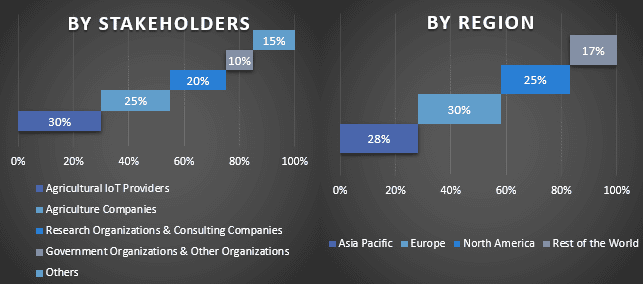
시장 엔지니어링
전반적인 시장 추정을 완료하고 글로벌 농업 IoT 시장의 각 세그먼트 및 하위 세그먼트에 대한 정확한 통계 수치를 도출하기 위해 데이터 삼각 측량 기술을 사용했습니다. 글로벌 농업 IoT 시장에서 구성 요소, 농장 유형 및 애플리케이션 영역의 다양한 매개변수와 추세를 연구한 후 데이터를 여러 세그먼트 및 하위 세그먼트로 분할했습니다.
글로벌 농업 IoT 시장 연구의 주요 목표
글로벌 농업 IoT 시장의 현재 및 미래 시장 동향이 연구에서 정확히 지적되었습니다. 투자자는 연구에서 수행된 질적 및 양적 분석에 대한 재량에 따라 투자를 결정하기 위해 전략적 통찰력을 얻을 수 있습니다. 현재 및 미래 시장 동향은 지역 수준에서 시장의 전반적인 매력도를 결정하여 산업 참가자가 미개척 시장을 활용하여 선점자 이점으로부터 이익을 얻을 수 있는 플랫폼을 제공했습니다. 연구의 다른 양적 목표는 다음과 같습니다.
- 가치(USD) 측면에서 농업 IoT 시장의 현재 및 예측 시장 규모를 분석합니다. 또한 다양한 세그먼트 및 하위 세그먼트의 현재 및 예측 시장 규모를 분석합니다.
- 연구의 세그먼트에는 구성 요소, 농장 유형 및 애플리케이션 영역이 포함됩니다.
- 농업 IoT에 대한 규제 프레임워크를 정의하고 분석합니다.
- 다양한 중개인의 존재와 관련된 가치 사슬을 분석하고 산업의 고객 및 경쟁사 행동을 분석합니다.
- 주요 지역의 농업 IoT 시장에 대한 현재 및 예측 시장 규모를 분석합니다.
- 보고서에서 연구된 지역의 주요 국가에는 아시아 태평양, 유럽, 북미 및 기타 지역이 포함됩니다.
- 농업 IoT 시장의 회사 프로필과 시장 참여자가 빠르게 성장하는 시장에서 유지하기 위해 채택한 성장 전략
- 산업에 대한 심층적인 지역 수준 분석
관련 보고서
이 상품을 구매한 고객님들도 함께 구매하신 상품





